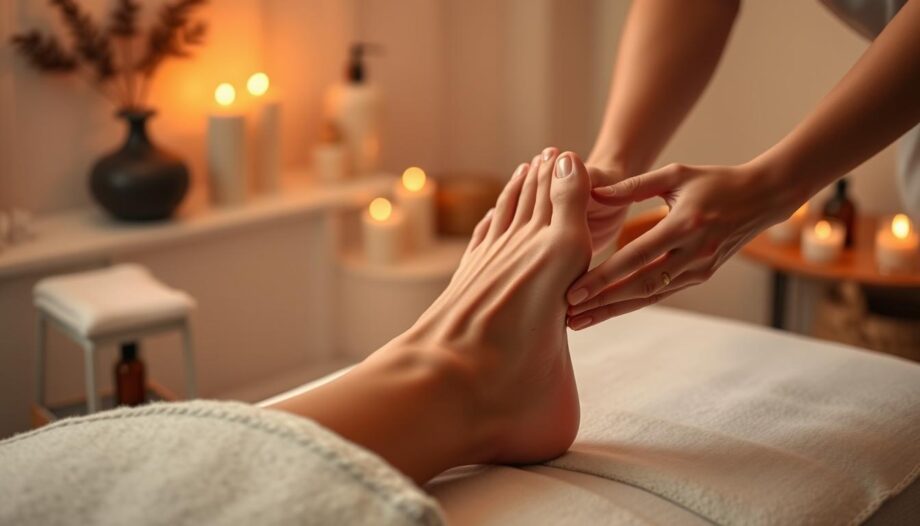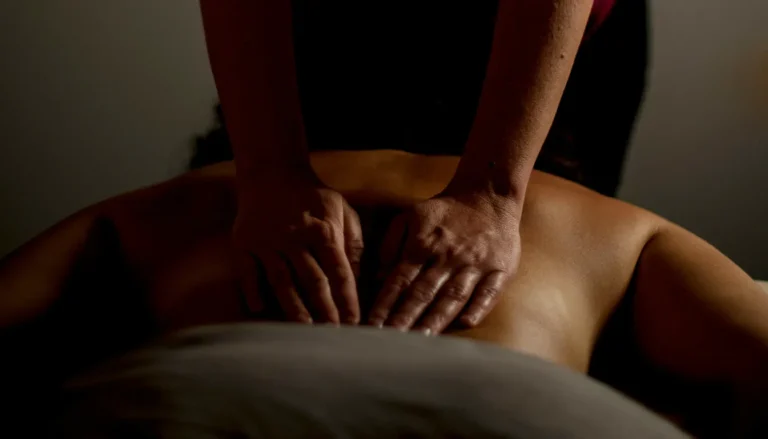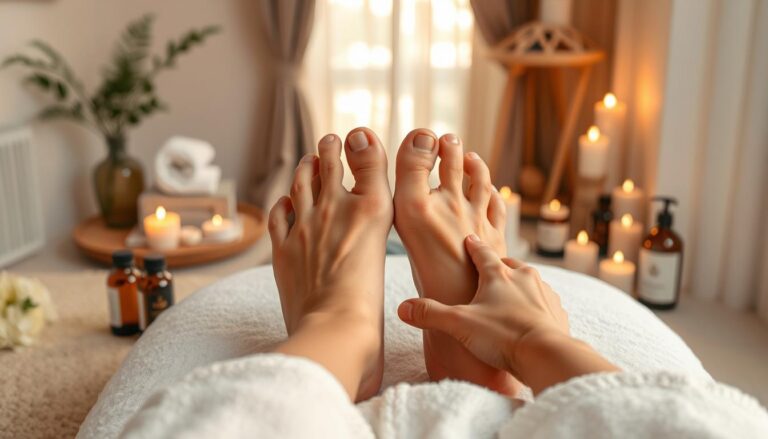Reflexology is a powerful holistic therapy offering remarkable health benefits. It uses strategic pressure points on feet, hands, and ears to boost overall wellness1. Research supports its potential to improve physical and mental well-being2.
This practice goes beyond traditional massage. It applies precise pressure to zones corresponding with different body systems. A thorough study of reflexology shows it can ease chronic pain and lower stress levels2.
Clinical studies reveal impressive results for various health issues. One study found 94% of chronic musculoskeletal pain patients reported significant pain reduction2. Male participants saw a 43% pain decrease, while females experienced a 41% reduction2.
Reflexology’s benefits extend to psychological improvements too. Seventeen studies confirmed it enhances overall well-being1. It also helps people manage their health conditions more effectively.
Reflexology offers a holistic approach to healthcare. It’s ideal for stress relief, pain management, and general wellness. This alternative therapy continues to fascinate both medical professionals and patients.
Understanding the Ancient Art of Reflexology
Reflexology is a fascinating healing practice with deep roots in ancient traditions. This therapy explores connections between body zones and overall wellness. It draws from centuries of holistic healing knowledge3.
Reflexology’s history spans remarkable civilisations. Evidence shows its use in ancient Egypt around 2500 BC. Similar techniques existed in China, Japan, India, and Greece3.
The concept of qi energy and meridians was crucial in understanding body healing. These principles guided early practitioners in their therapeutic approach.
Traditional Chinese Medicine Connection
In Traditional Chinese Medicine, reflexology balances qi energy throughout the body. Practitioners believe pressure points on feet and hands connect to internal organs. This enables healing through targeted touch.
The philosophy suggests disrupted energy flow can cause health imbalances. By addressing these blockages, reflexology aims to restore harmony.
Zone Theory and Body Mapping
Zone therapy emerged as a groundbreaking approach in the late 19th century. Dr William H. Fitzgerald divided the body into ten longitudinal zones3.
Key developments included:
- Identifying specific pressure points
- Mapping connections between body parts
- Understanding pain relief mechanisms
Doctor Shelby Riley later expanded this theory. He introduced horizontal zones on hands and feet3.
How Energy Flow Affects Wellness
Reflexology uses strategic pressure to restore natural energy pathways. By stimulating specific meridians, practitioners aim to:
- Reduce stress
- Enhance circulation
- Promote natural healing
The Association of Reflexologists, established in 1984, promotes and regulates this ancient healing practice3.
The Science Behind Reflexology Body Massage
Reflexology explores the links between touch therapy and the human nervous system. Scientists have found how gentle pressure can trigger profound bodily responses. This practice examines how skin stimulation connects to internal organ function.
Our nervous system is key to interpreting and responding to touch. Reflexology targets specific nerve endings, potentially affecting pain perception and stress levels. Practitioners aim to stimulate neural pathways and promote healing.
- Stimulate neural pathways
- Release tension in the body
- Promote natural healing mechanisms
Studies show reflexology can greatly impact overall wellness. The body’s natural pain-relieving chemicals, known as endorphins, may be triggered during these sessions4. This process could help manage pain and reduce stress-related symptoms.
Reflexology offers a holistic approach to understanding the body’s interconnected systems, revealing how touch can influence our physiological responses.
Stress contributes to up to 80% of illness development. This makes reflexology a potential tool for preventative healthcare. The technique focuses on reflex zones that correspond to different body parts.
Reflexology’s exact mechanisms remain partly unknown. However, it continues to intrigue medical researchers. Its potential to support the nervous system and promote relaxation is fascinating.
Key Health Benefits of Reflexology Treatment
Reflexology offers a holistic approach to wellness. It targets multiple aspects of physical and mental health. This ancient practice provides natural solutions for chronic pain relief and anxiety management.
Reflexology reveals remarkable health advantages. It addresses various wellness challenges effectively. Its therapeutic potential is truly impressive.
Pain Management and Relief
Reflexology is powerful for managing chronic pain. Research shows significant benefits for those with persistent discomfort. A study found 55% of participants experienced substantial migraine relief through regular treatments5.
Remarkably, 23% reported complete cessation of migraine symptoms5. Additionally, 11% even stopped their medication5. These results highlight reflexology’s effectiveness in pain management.
Stress and Anxiety Reduction
Reflexology is crucial for anxiety management. It promotes relaxation and emotional balance. Studies show foot massage can lower stress levels, reducing tension and anxiety6.
Practitioners have observed significant improvements in several areas. These include mood regulation, emotional well-being, and sleep quality.
- Mood regulation
- Emotional well-being
- Sleep quality
Improved Circulation and Energy Balance
Reflexology shows potential for enhancing blood flow and energy balance. Foot massage techniques improve circulation, leading to multiple health benefits6:
- Reduced systolic blood pressure
- Decreased blood triglyceride levels
- Enhanced overall mobility
“Reflexology is not just a treatment, but a pathway to holistic healing and wellness.”
These findings highlight reflexology’s potential as a natural, non-invasive approach. It effectively supports both physical and mental health. Reflexology offers a comprehensive solution for overall wellness.
Understanding Different Pressure Points and Their Effects
Reflexology maps showcase interconnected body systems through specific pressure points. Each foot, hand, and ear area contains unique zones corresponding to different organs. These maps guide practitioners in holistic healing7.
Foot pressure points are particularly intriguing. Different regions map directly to specific body parts:
- Toes: Represent the head and neck regions
- Ball of the foot: Connects to chest and lung areas
- Heel: Linked to lower back and reproductive systems
Hand reflexology offers similar healing potential. Practitioners apply pressure to hand zones to stimulate corresponding body systems8. These techniques can potentially reduce chronic pain and anxiety.
- Reduce chronic pain
- Decrease anxiety levels
- Improve overall wellness
“Every point on the body tells a story of health and healing” – Reflexology Wisdom
Ear reflexology presents another fascinating approach to holistic treatment. Specific ear points can trigger responses in various body systems9. This may offer relief from multiple conditions.
Studies suggest reflexology might increase blood flow and relieve pain. It may also support managing sleep disorders7. More research is needed, but many report positive experiences with these ancient techniques.
Professional Treatments vs Self-Massage Techniques
Reflexology offers two distinct approaches to wellness: professional treatments and self-administered techniques. Understanding these methods can help you maximise the benefits of your reflexology practice. Each approach has its own unique advantages.
Finding a Qualified Certified Reflexologist
Selecting a certified reflexologist with proper credentials is crucial. Look for practitioners registered with recognised professional bodies like the Complementary and Natural Healthcare Council10.
A qualified expert can provide targeted treatments for specific health concerns. These treatments are often more effective than self-massage techniques11.
- Check professional certifications
- Verify membership in recognised organisations
- Review client testimonials
- Discuss your specific health goals
Steps for Self-Administered Reflexology
Self-care through reflexology can be an empowering journey. Start by creating a calm environment and using appropriate reflexology tools.
Comfort and consistency are key to effective self-massage.
- Select a quiet, comfortable space
- Use foot rollers for initial warm-up
- Apply gentle pressure using thumbs
- Focus on specific reflex points
- Stop if experiencing sharp pain
Essential Reflexology Tools and Products
Quality reflexology tools can enhance your self-massage experience. Consider these essential items for your practice:
| Tool | Purpose | Recommended Use |
|---|---|---|
| Foot Rollers | Muscle tension relief | Daily 5-10 minute sessions |
| Massage Balls | Targeted pressure points | Gentle rolling techniques |
| Reflexology Stick | Precise pressure application | Specific zone stimulation |
“Self-massage is an art of listening to your body and responding with compassion.” – Wellness Expert
Combining professional treatments and self-massage techniques offers a comprehensive approach to reflexology. Professional sessions provide expert insights and targeted treatments.
Self-care empowers your personal wellness journey. Together, these methods create a balanced and effective reflexology practice10.
Conclusion
Reflexology is a powerful complementary therapy offering natural healing. It improves overall well-being by addressing physical and emotional health aspects. This holistic practice can reduce stress, alleviate pain, and boost energy levels12.
Studies show impressive results across various health dimensions. People receiving regular reflexology report better sleep quality and emotional resilience. It triggers healing responses, making it valuable for non-invasive health management1213.
However, it’s crucial to approach reflexology mindfully. Consult healthcare professionals, especially if you have specific health conditions. This gentle therapy supports the body’s healing mechanisms13.
FAQ
What exactly is reflexology?
Reflexology is a holistic massage technique. It involves applying pressure to specific points on feet, hands, and ears. These points correspond to different body systems, aiming to promote relaxation and improve well-being.
Is reflexology scientifically proven?
Scientific research on reflexology is still limited. However, some studies suggest potential benefits. British scientists found nerves connecting skin and internal organs.
Reflexology may help calm the central nervous system. This could reduce stress and alter pain perception.
What health conditions might reflexology help with?
Research shows reflexology may help manage various conditions. These include chronic pain, post-operative pain, and premenstrual syndrome (PMS). It might also aid with depression, anxiety, and sleep issues.
Reflexology may reduce stress in patients with chronic conditions like multiple sclerosis.
How does reflexology relate to traditional Chinese medicine?
Reflexology has roots in traditional Chinese medicine. It focuses on qi, or vital energy, flowing through the body. The practice aims to balance this energy and prevent illness.
Can I perform reflexology on myself?
Yes, self-administered reflexology can be beneficial. Start by sitting comfortably and massaging one foot at a time. Use your thumb to make small circles from heel to toes.
Gently rotate each toe. Tools like foot rollers can help. Use moderate pressure and stop if you feel sharp pain.
How do I find a qualified reflexologist?
Look for a certified reflexologist registered with reputable organisations. In the UK, check the Complementary and Natural Healthcare Council. Verify their credentials, experience, and professional memberships before booking.
Are there any risks associated with reflexology?
Reflexology is generally safe for most people. However, some health conditions may require doctor consultation first. It’s a non-invasive therapy that can complement traditional medical treatments.
How often should I have a reflexology treatment?
Treatment frequency depends on individual needs and health goals. Some benefit from weekly sessions, while others find monthly treatments sufficient. A professional reflexologist can provide personalised advice based on your health conditions.
What should I expect during a reflexology session?
During a session, you’ll remain fully clothed. You’ll usually lie on a treatment table or sit comfortably. The reflexologist will apply pressure to specific points on your feet, hands, or ears.
The experience is generally relaxing and shouldn’t be painful.
Can reflexology help with stress relief?
Yes, stress reduction is a primary benefit of reflexology. It stimulates specific nerve points and promotes relaxation. This can help lower stress levels and calm the nervous system.
Reflexology may also improve overall mental well-being.





